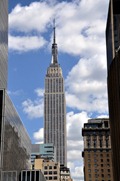Poster Child for the Environment: The Empire State Building
by Melinda Burns, MILLER McLUNE, Mary 3, 2010
 Anthony Malkin, the owner of the Empire State Building, is an environmentalist — but he’s also a capitalist. If he’s going to spend $20 million on an energy retrofit of his famous skyscraper, he wants a guaranteed three-year payback and long-term savings.
Anthony Malkin, the owner of the Empire State Building, is an environmentalist — but he’s also a capitalist. If he’s going to spend $20 million on an energy retrofit of his famous skyscraper, he wants a guaranteed three-year payback and long-term savings.
“There was no assurance that what we were going to do was going to be successful,” Malkin recalled this month, a year after he launched the project with a green light show at the historic landmark, the 10th tallest building in the world. “We knew that if we could do this work at the Empire State Building, one of the largest tourist attractions in the world, the world was going to stand up and take notice.”
So, Malkin and a team of experts from the Clinton Climate Initiative, a program of the New York-based William J. Clinton Foundation; Rocky Mountain Institute, a Boulder, Colo., “think-and-do tank”; Jones Lang LaSalle, a global real estate investment firm with headquarters in Chicago, and Johnson Controls Inc., a Milwaukee-based firm that serves the global building efficiency market, spent nine months quietly examining 67 ways to reduce energy use at the pre-World War II office tower.
When Malkin realized he could get an ironclad guarantee for a 38 percent reduction in energy use by 2013, together with an annual $4.4 million in savings, he went public with his plans.
The “deep energy retrofit” at the 102-story Empire State will refurbish 6,500 windows; install sensors, automatic dimmers and high-efficiency light bulbs; put reflective barriers behind radiators; renovate the heating and cooling systems; provide electrical meters for tenants’ offices and work with tenants to make sure that they maximize the use of natural light. Far from being an outmoded liability, the skyscraper’s windows are “a key to efficiency,” Malkin said. With sensors, the office lights will automatically switch off when enough sunlight enters a room.
Many studies show that energy retrofits in commercial buildings deliver good bang for the buck: They reduce more greenhouse gases for less money than it would take to electrify the transportation fleet or upgrade industrial operations. And as Malkin has discovered, ambitious retrofits can have a financial payback for owners.
But progress in the efficiency field overall has been hampered by the up-front capital cost of renovations and the complexities of landlord-tenant relationships over who should pay.
Last year marked the end of the first decade of the Energy Star for building efficiency, a voluntary rating program administered by the U.S Environmental Protection Agency. To date, the EPA has qualified 9,700 commercial, or non-residential, buildings for the Energy Star label, out of 5 million commercial buildings nationwide.
Last year alone, a record 3,900 such buildings received the Energy Star label. At that rate, it would still take more than 1,000 years for the U.S. to upgrade its commercial building stock.
A 2009 report on building efficiency in the U.S., European Union, Japan, China, India and Brazil, a project of the World Business Council for Sustainable Development, a global CEO-led association of more than 200 companies, bluntly called the status quo “sleepwalking into crises.” [Read entire story]


